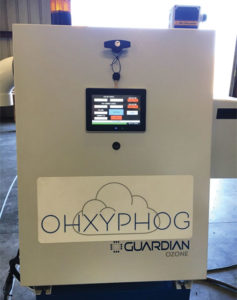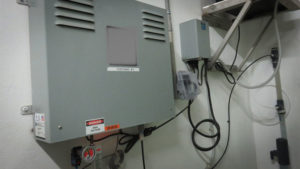Food Safety: Once More Into the Ozone
We are riding another wave of keen interest in the potential for ozone-treated water (ozonation) to supplement or wholly substitute for current antimicrobials added to postharvest wash and cooling water. Similarly, gaseous ozone and ozone-fogging applications are triggering cautious interest for surface sanitization in pre-coolers and cold storage.
The attraction to drop other chemistries, predominantly various chlorine-based formulations, in favor of ozone is clear:
- Ozone is a powerful oxidizing agent
- Ozone is FDA-listed as Generally Recognized As Safe (GRAS)
- Ozone is allowed as an “ingredient” under the USDA National Organic Program
- Ozone lethality to viruses and parasites in contaminated water far exceeds chlorination
- Ozone treatment enhances water reuse systems by micro-flocculation of suspended particulates
- Ozone has been shown to degrade pesticide residues in reuse water and on fruit surfaces
- Ozone creates negligible disinfection by-products
- Ozone breaks down to atmospheric oxygen
Postharvest water ozonation, in particular, in the fresh produce sector has increased over the past 10 years, including with tree fruit and vine crops. Ozone generation and delivery-device suppliers (ozone generators) cite recognized safe and effective use in water treatment since the early 1800’s, with levels as low as 1 ppm.

(Photo: Trevor Suslow)
As an antimicrobial oxidizer, consider the following equation: Ozone > Peroxyacetic Acid > Hydrogen Peroxide > Hypochlorous Acid > Chlorine Dioxide. Each of these chemistries has some advantages and other mechanisms of antimicrobial action, such as being both an oxidizer and metabolic poison to microbes, but that is for another article.
Results Aren’t There
However, decades of promise from bench-top studies and volumes of peer-reviewed papers has have not resulted in broad and effective application of water ozonation in fresh produce packing as the sole antimicrobial additive to a postharvest packing process. Along with the impressive list of beneficial traits, there are equally apparent limitations.
Up front, I want to share that I have conducted many lab, pilot-scale, and on-site tests with various ozone-based systems for more than 25 years, most recently within the past six months. Ozone can be a powerful addition to your quality and safety management toolbox but comes with a fairly long list of caveats and qualifiers. These precautionary notes run the full range of worker safety, compatibility with legacy equipment and materials, application-specific performance limitations, and, naturally, cost considerations.
In my experience, the most straightforward and beneficial use of ozone in fruit handling and packing is as a terminal rinse step and as the post-ultrafiltration treatment of re-circulated water in postharvest wash and fluming systems.

(Photo: Trevor Suslow)
Another commonly beneficial application is cold storage or forced-air treatment with gaseous ozone or room fogging. The most cost-effective applications to room ozonation are for bulk-stored product packed to order rather than pre-packed cartons. In long-term cold storage, whole-system designs including bin stacking, sensor deployment, and detailed airflow mapping to minimize dose gradients are critical for beneficial outcomes within a lot and to prevent ozone injury to the product, especially during storage and distribution. Additionally, the cost of facility and equipment conversion or design to ozone-compatible materials and components must be considered.
A tree fruit grower/shipper recently asked me, “Why can’t we make ozone work in our pack-line?” My simple answer was that you could if you develop an integrated system to allow it to provide a benefit. Don’t expect a “‘silver bullet”’ outcome to microbial control objectives with ozone.
Don’t fall for a simple plug-and-play marketing scheme to work by merely installing an ozone generator and injection point. You have to define your expectations for where and how your operation will realize a value to product quality and environmental management.
A key issue here is that the majority of peer-reviewed journal papers extolling the promise of both gaseous, fogging, and aqueous ozone treatment for quality, decay control, and food safety fail to provide a true practical context for efficacy expectations to the end user. Without getting too deep into the weeds of technical issues and experimental methods, the microbial challenges using lab-grown cells are too likely to over-predict lethality in a commercial context. In the absence of a demonstrated performance in lethality to naturally occurring and environmentally adapted index microbes, expectation for claimed 99.99% or 99.999% kill of some target-inoculated pathogen is highly suspect.
Assess Carefully
Similarly, model systems, which report outstanding pathogen kill potential, often have incompatible parameters for dose and product exposure duration or uniformity of contact for high-throughput handling systems. There are some applications with good potential for performance as surface sanitizers on product, on equipment, and in cold storage but careful assessment under the conditions of use generally find the flaws and limitations in a hurry.
One of the common pitfalls is matching the ozone Ct exposure (Concentration x Time) curves for phytotoxicity (product injury) to microbial disinfection (log kill) of the naturally present index microbes mentioned above. Some commodities have good ozone exposure tolerance but our experience has been that a number of inherent fruit traits and influencing preharvest factors lead to injury well below the threshold for beneficial levels of pathogen control, whether postharvest decay spores or foodborne human pathogens.
Recently, I have had the opportunity to observe systems in a few locations with recent installations of ozonated wash-rinse systems for fruit handling. Realistically, from some preliminary tests, the greatest benefit is realized for in-shift control of microbial build-up on produce contact and adjacent non-contact surfaces.










